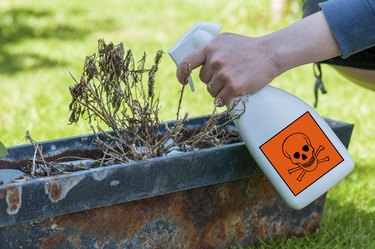
Weed killers harm weeds and many other plants, but there are weed killers that target only certain plant types and leave others undamaged. These products are called selective weed killers, and they include chemicals that control either grasses or broad-leaved plants. Nonselective weed killers, which are often labeled "grass and weed killers," control most plant types and shouldn't be used near plants you wish to keep. Covering desired plants with cardboard, and leaving it in place until the weed killer has dried, offers good protection. Many natural herbicides, such as salt and detergent, also harm most plants.
Weed Killers for Grasses
Video of the Day
Herbicides for grasses control grasses you find undesirable, but they also harm lawns and ornamental grasses. Chemical ingredients in weed killers for grasses include sethoxydim, fluazifop-p-butyl and clethodim. Sethoxydim and fluazifop-p-butyl control most grass weeds, but clethodim is not very effective against goosegrass, which is an annual grass weed. Weed killers for grasses only affect existing grasses. They don't linger in the soil or prevent grass seeds from sprouting. Vinegar suppresses grasses when diluted at a rate of 26 fluid ounces per 1 gallon of water but doesn't provide good control.
Video of the Day
Controlling Grasses
The best time for using a selective weed killer to control grassy weeds is when the weeds are actively growing. Put on protective clothing including a hat, safety goggles, a long-sleeved shirt and long pants before using weed killers. Spray the center of the grass clump with a selective grass herbicide, such as a ready-to-use product containing 0.48 percent fluazifop-p-butyl. Apply the herbicide again after seven days and in another seven days as often as needed. Manufacturer's instructions vary among products, so always read the label before applying a herbicide.
Weed Killers for Broad-Leaved Weeds
Weed killers for broad-leaved weeds control weeds in lawns without harming the grass. Broad-leaved weeds such as dandelion (Taraxacum officinale), which grows in USDA zones 3 through 10, regularly invade lawns and other grassy areas. Chemicals that control annual and perennial broad-leaved weeds include halosulfuron, bentazon, imazaquin, mecoprop (MCPP), dicamba and 2, 4-D. Most of these chemicals harm ornamental plants should not be used in garden borders or near plants you wish to keep. Products containing only halosulfuron as an active ingredient can often be used around woody ornamental plants as a spot spray, but check the instructions on the product label.
Controlling Broad-Leaved Weeds
Herbicides for controlling broad-leaved weeds often contain three or more active ingredients. A ready-to-use product containing 0.05 percent dicamba, 0.12 percent 2, 4-D and 0.22 percent MCPP works best when the weeds are actively growing and daytime temperatures are between 45 and 90 degrees Fahrenheit. Put on protective clothing, and spray the product on the weeds' leaves on a dry, still day. Don't apply herbicides to a drought-stressed lawn -- water the lawn thoroughly and apply the herbicide three days later. The manufacturer's instructions may vary, so read the product label and follow the directions. These weed killers can harm the roots of ornamental plants growing under a lawn.
- UC Statewide IPM Online: Weed Management in Landscapes
- University of Tennessee Extension: Common Herbicides for Ornamental Weed Control
- ZipcodeZoo.com: Acrachne Racemosa
- ZipcodeZoo.com: Taraxacum Officinale
- UC Statewide IPM Online: Weed Management in Lawns
- University of Minnesota Extension: Weed Management